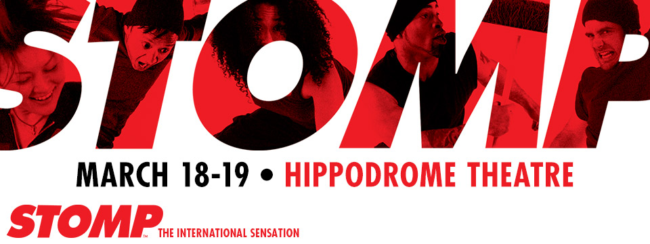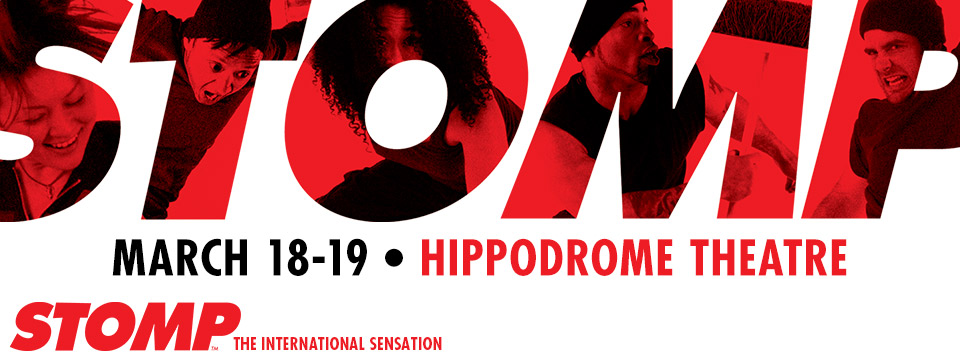Are you ready to hear them? STOMP— the international touring sensation— is taking a brief trip into Charm City and TheatreBloom was fortunate enough to score a brief interview with one of their fantastic performers, Simeon Weedall. Sit back and enjoy the sounds of this percussive dancer as we talk one on one with Simeon about the STOMP Experience.
Thanks for chatting with us, if you’d just give us a quick introduction, we’ll get started!

Simeon Weedall: My name’s Simeon Weedall. I’m a performer, dancer, actor, and drummer. I come from Brighton, which is actually where the show originated. STOMP started in Brighton, we’re looking at 25 years ago. I was eight years old; I’ll let you guys do the math on that. I remember seeing STOMP before they were STOMP performing on the street of Brighton. As an eight-year-old child, seeing that on the street, something about it definitely just stuck with me. I never dreamed I would be in the show. Or that I would be part of STOMP, but there’s definitely something that stuck with me there and it’s been a journey ever since.
I grew up performing ever since I was ten years old. My father used to write and direct plays, in fact he still does in his spare time. My dad would put me in his plays and I’d have lines to learn and I’d have to get into character as a ten-year-old child. Me and my father really shared a nice relationship in terms of the performing element of our lives. As I started growing up, I started exploring percussive tap dance. I went to train at a place called The London Studio Centre, which is in King’s Cross, London. For those of you that go to King’s Cross these days it’s actually rather gentrified and rather nice. A few years ago, King’s Cross was a little rough around the edges; it was considered the “red light district” of London. You had a lot of criminals. And you had a lot of dancers. It was a very strange combination.
The training that I had there was very disciplined. My tap teacher was extremely disciplined. He was in the army. His name is Bill Drysdale. He’s notorious for throwing chairs at students when they go wrong. Obviously the teaching’s changed in the last few years. We’re a bit more well-rounded these days and everybody’s kind of PC. But actually, underneath all of that discipline, he was a real softie. He really cared about his students. He had a very good sense of humor. There’s an old-school element of discipline in me as a performer, I got that from my training and it’s in me and I kind of enjoy it. I try to bring that to my daily life.
I left training. I wanted to pursue a career in musical theatre for a while there, but I was a percussive tap dancer first. I was exploring other elements of performing. I did about three years in the musical Chicago. I toured and played in the West End. I left that and formed two of my own companies. The first one was called About Time— a percussive tap dance company. We took it to about five theatres in the UK. I was teaching and freelancing as a tap soloist while that was going on. The second company I spawned was actually through jamming with musicians. This very established jazz musician in the UK, this guy called Paul Booth. He’s a fantastic jazz saxophonist, if you get a chance to listen to his stuff— he’s amazing. And Theseus Gerard, who was an original STOMPer, he was playing percussion for me. At some point, I got a call— I was on the road with a different show in Germany— and STOMP called and asked if I fancied doing some shows with them.
So happenstance landed you with STOMP?
Simeon: Let me rewind a little bit here, I’ve skipped the bit where I auditioned. I saw the ad in the newspaper, and thought I had no idea what it would be all about but I went along and checked it out. It went pretty well. It was good fun. The auditions are less like auditions and more like workshops. They’re just trying to see if you’re a good fit. So I got that phone call a couple of months later, asking if I wanted to come try and learn the show. I’ve been with the show for eight years now. I started out in the London show, and I spent some time in the European tour, which is more like a world tour because it goes everywhere now. Last year was my first US tour. I did about eight months in New York and this is my second US tour, it’s going very well.
You keep mentioning “percussive tap” Can you explain what that is and how it differs from ordinary tap or other styles of dance?
Simeon: That’s a great question. Percussive tap is focusing more on the sound and rhythmic exploration with tap shoes on and less of the dance element involved there. I’m a big fan of some of that show-based tap stuff. I was a big fan of it when I was younger. Then I just left it behind and started exploring tone and sound, which sounds immediately less impressive. But I assure you the discipline of that and learning to improvise? It becomes an expression of yourself and your own music. People who do it have to study jazz or listen to lots of jazz. They have to listen to lots of different types of music and learn how to play music with their feet.
Say for instance one day you wanted to become a jazz pianist, like most people who start out with no knowledge, you’d spend a lot of time working on the scales, working on the chords, trying to link them and put them together. It takes a good 10,000 hours, they say. You know, you’ve got to do a good 10,000 hours before you’ve really got this down. It’s a real art form. There is no money in it. We don’t do it for the money. That, plus a little bit of playing drum kit has been a good pathway into STOMP because STOMP is its own thing.
STOMP is making music, making percussion, making rhythm with everyday objects. The weight change in tap really helps the understanding of the rhythmic concepts. It just served me personally as a good pathway for how I could fit into STOMP.
What is it about the type of performance that you do in STOMP that speaks to you as a performer that makes you want to do it rather than say musical theatre or other types of dance and performance?

Simeon: I’d say the answer to that is communication with other people, particularly with other performers. And obviously the audience. There is a lot of space for us to be unique in STOMP. I think STOMP has an ongoing relationship with its audience because every time they come back they see a different performer or a different organization of the same performers. After the show, people have come up to me and have said, “That was totally different. I saw it three years ago but that just now was totally different.” And they’ve have this completely different experience and they can’t quite say why. But they know something felt different about it. It’s because we all an individual take within the framework of STOMP.
That keeps my level of interest going. Secondly, the music— we’re able to write solos and improvise solos. There is a constant journey that’s happening. We never reach the end of it, you know what I mean? It’s not like we say “Oh, I’ve done that now” and then we tick the box and leave. I think as long as you keep that journey going, that level of inquiry alive, you can’t get bored. You can’t run out of ideas. It’s constantly a challenge and every day you can bring something new. And to go back to what I said earlier about communicating, music— personally for me— is about communication. It’s just about making someone understand a little beat or an eight-bar phrase that you’ve written. It’s about getting someone to nod their head or tap their foot. If you see someone nodding their head or tapping their foot in the audience— I think that’s the job more so than trying to show off your chops and impress people.
You want to get the room moving. You want to get the theatre moving. If they can feel the rhythm to the point where it gets them moving? It’s probably more interesting and more exciting than someone who’s playing 100 licks a second or being very impressive. There’s an element of vulnerability there. There’s a lot of comedy in it. There’s no words spoken. It’s entirely physical. It’s entirely percussive. And a lot of people find the comedic elements to be the biggest level of interest in the show. It’s all these little pieces. It’s like ants performing in an anthill. Every little piece fits a beat and creates this bigger picture. All these pieces fit together and make the show STOMP and it’s a different arrangement every show. It’s a fascinating company to be a part of. It’s wild and weird and whacky and wonderful and I feel lucky to have been a part of it as a performer for the short amount of time, which is eight years, that I’ve been a part of it.
What has being with STOMP for that “short” period of eight years taught you about yourself? What have you learned?
Simeon: I’ve learned that there is a level of democracy required to create music together. Musicians play in lots of different ways and they have lots of different takes on how to play this or that. Everyone has a different feel. They might be pushed— I mean slightly ahead of the beat when I say pushed— by like a hair, a miniscule amount. But a different player might be slightly behind the beat, we call it laid back. When you put those two players together they do not match. It sounds like they’re not playing together at all. So we’ve got to get one of them to push up slightly and the other one to pull back slightly so that they meet together in the middle. They have to meet in the middle and find a common ground to make that work. That requires a little bit of change inwardly. You have to lose a bit of your ego.
I think that’s one of the most positive things that I’ve experiences. I lost my ego. It’s a wonderful thing. It’s very freeing. Of course, everyone still has an ego, but realizing that you have to be very democratic in order to make this musical creation process work, it’s very helpful. Also, sometimes, people are just wrong, and you just need to say “that was wrong.” And that’s that. Because we all go wrong. That’s the beauty of live theatre, you know what I mean? Everybody goes wrong, by miniscule amounts. Sometimes something breaks in the show— like the brooms.
The opening bit of the show is done with brooms and sometimes a broom will snap. And that becomes interesting because we have to throw it off, and find another one and carry on. But that reveals something a little more vulnerable than just “hey, we’re good at this!” It’s more interesting if an audience can see, “hey, something’s gone wrong but they’re making it work.” Sometimes those are the best shows, the ones that are a bit more vulnerable because the audience picks on that. They realize that they’re not watching YouTube or a Hollywood film where everything has been edited and chosen and all the best bits have been cherry-picked. That’s not live theatre, is it? It’s live, so there’s an element of risk in there that things might go wrong and it’s our responsibility as a cast to make things work and keep the show going even though something has gone wrong. I think the mistake element— the happy accident— really adds to the vulnerability and makes it so much more interesting to watch.
What is it that you’re hoping people will take away from seeing STOMP?
Simeon: I don’t really mind as long as they’ve enjoyed themselves, that’s the main thing. Some folks who play musical instruments and understand that will probably most likely start pointing out the bits of music they liked in certain pieces. Also I hope they have a good laugh. It’s genuinely funny at moments. I think people who appreciate that side of things will enjoy that. Whatever it is that this makes you feel as a human being— which is quite a big question since everyone feels a little bit differently about everything when you sum it up— but I hope everyone has a good time. Now, you can’t please all the people all the time. That’s the rule of thumb. It’s a rule of life. In any business, in any show, not everyone is going to like it all the time, but people do seem to like this and there are fans and they do come back. I hope for the people that do come back or for the people that are watching it for the first time that they get something out of it that is for them an experience. When I saw the show for the first time, I came out of it and felt like I had had a percussive experience. I felt lifted. Music has the power to lift us. It’s a little freeing like that. I hope either they’re inspired or they get a good feeling or they have a good laugh. Or all three of those things.
STOMP is making a brief visit on March 18th and 19th, 2017 to the France-Merrick Performing Arts Center— 12 N. Eutaw Street in the Bromo Seltzer Arts District of Baltimore, MD. For tickets call the box office at (410) 752-7444 or purchase them purchase tickets online.

